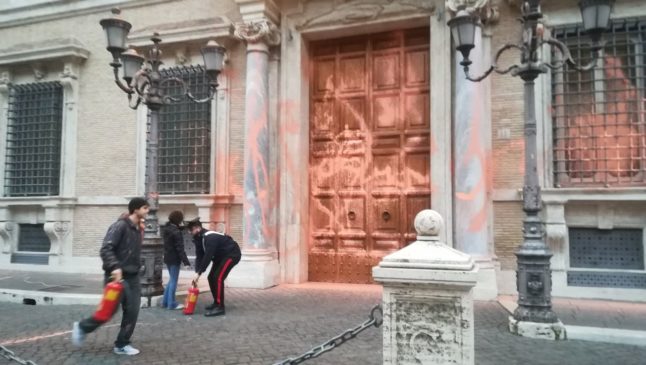Activists Laura, 26, Davide, 23, and Alessandro, 21, who belong to the Last Generation group and go by their first names, are accused of criminal damage and risk up to three years behind bars.
They were among five climate activists who on Monday used fire extinguishers to spray the front of the upper house of the Italian parliament in Rome with washable orange paint.
It was just the latest of a series of protests in which activists have thrown paint or flour at, or glued themselves to, notable artworks or buildings in Italy, most recently Milan’s La Scala opera house in December, in a bid to focus political and public attention on impending climate disaster.
Their actions were in response to the “willingness of political and economic elites to deliberately choose to condemn much of the global population to drought, famine, war and death,” Laura said in a statement.
Police quickly arrived on the scene on Monday as the activists hurled orange paint across the windows, walls and vast wooden door of Palazzo Madama, home of the Senate.
❗️3 attivistə di Ultima Generazione sotto arresto❗️
Laura (26 anni), Davide (23) e Alessandro (21) sono in stato di arresto a seguito dell'imbrattamento al Senato, con accusa di danneggiamento.#clima #senato #crisiclimatica #ClimateEmergency #gas pic.twitter.com/jdKexLTajL
— Ultima Generazione (@UltimaGenerazi1) January 2, 2023
They seized the fire extinguishers and detained all five activists, before releasing two.
Last Generation said the arrests were “aimed at intimidating and criminalising those who are trying to bring attention to the real crime that this government is perpetrating”.
READ ALSO: Why are climate protesters glueing themselves to Italian artworks?
The trial for the three arrested will begin on May 12, their lawyer Ilaria Salamandra told AFP.
“The defence hopes the court will change the offence,” reducing it to soiling rather than damage, a lesser charge that carries a punishment of between six months to one year, she said.
Italy’s far-right Prime Minister Giorgia Meloni slammed the protest as an “outrageous gesture”, while Senate speaker Ignazio La Russa, from Meloni’s Brothers of Italy party, said it was “cowardly”.
Stefano Feltri, editor of the left-wing Domani newspaper, noted on Monday that climate activists in Italy were “treated more harshly than hooligan leaders who collude with organised crime”.
Rischiano molto, sulla propria pelle. E per questo sarebbe consigliabile giudicarli con meno superficialità e farsi qualche domanda https://t.co/W25wNwC0YL
— Bruno Simili (@bruno_simili) January 2, 2023
Last Generation began carrying out peaceful but disruptive protests in Italy last year ahead of the general election, urging politicians from all parties to make climate change their priority.
READ ALSO: Climate activists hurl pea soup at Van Gogh painting in Rome
Activists threw paint at Milan’s famed La Scala opera house last month and have targeted artworks in museums in protests designed not to damage the works, but rather to highlight the risk of environmental disaster.
The group wants Italy to invest more in renewable energy, pause the reopening of old coal power plants, and cancel all fracking operations.
The protests in Italy are part of a series of actions across Europe to focus attention on climate change.
Activists have targeted masterpieces such as the “Girl with a Pearl Earring” by Johannes Vermeer at The Hague’s Mauritshuis museum, Klimt’s “Death and Life” in Vienna’s Leopold Museum or Van Gogh’s “Sunflowers” at London’s National Gallery, hurling soup or other food at the paintings behind glass.




 Please whitelist us to continue reading.
Please whitelist us to continue reading.
Member comments